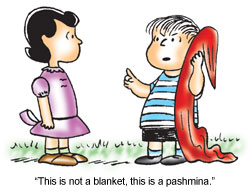|
|
| PASSIONATE ABOUT PASHMINA: Value added pashmina products include dressing gowns and scarves |
Pashmina making began as a cottage industry, catering mainly to the local market. The few investors who saw its potential had to be patient before profits began to flow. And just as they started earning dividends, the industry realised it had one more lesson to learn-it's not easy doing business in an era of globalisation.
When Nepal's neighbours saw pashmina's potential, they brought economies of scale and just copied the product. There was a glut in the market, prices went into freefall. The Chinese had cheaper labour, lower production costs, skilled manpower and most importantly, their own raw material, something that Nepal was actually importing from the northern neighbour.
The Indians for their part used the age-old vanishing trick-importing Nepali pashmina, tinkering with it and then exporting cheaper products with the Nepal label. Low-price Indian and Chinese pashmina items, even fakes, began circulating in international markets, striking at the heart of Nepal's industry. Unfortunately this was exactly what makers here tried to copy. "Indians totally spoilt the market for us. They had variety, and embroidery skills, which we did not. Maintaining quality in the face of competition was tough," explained Roshan Timilsina of Innoxa Pashmina, whose main markets were Italy, Japan and Korea.
By this time everyone in Nepal wanted a piece of the pashmina pie. A Rastra Bank study shows that the number of registered factories jumped from 25 in 1993 to 959 by 1999. The 70-30 formula (70 percent pashmina and 30 percent silk), which had worked fine till then succumbed to competition and woollen shawls and other items began to be passed off as pashmina.
 With the markets tightening, the unregistered factories were the first to go but the long-term businessmen were wounded. Not only did exports nosedive, retail businesses that relied on tourist buyers also suffered. Shopkeepers like Bishnu Dhungel of Lovely Handicrafts in Basantapur today spend the day waiting for the odd tourist to appear. Days of no business are not uncommon. Timilsina closed his factory more than a year ago and now only calls his workers when there are large orders.
With the markets tightening, the unregistered factories were the first to go but the long-term businessmen were wounded. Not only did exports nosedive, retail businesses that relied on tourist buyers also suffered. Shopkeepers like Bishnu Dhungel of Lovely Handicrafts in Basantapur today spend the day waiting for the odd tourist to appear. Days of no business are not uncommon. Timilsina closed his factory more than a year ago and now only calls his workers when there are large orders. But after years of downturn, it looks like the industry is coming out of the slump. The government has promised reforms to help them, like a refund on VAT, duty drawback and bonded warehouses.
 People like Pushpa Man Shrestha of Nepal Pashmina Industry, one of the main players in the business for more than two decades, are still hopeful. "The US and Europe still have a soft corner for Nepali pashmina," he says. "It's a question of survival. The Chinese and the Indians are too large for us to compete with so we have found ways to overcome the challenge." Nepali pashmina-makes are now restricting themselves to shawls but have focused on niche markets of apparel and household items made from the fabric. The other pashmina items are: pillow cases, bedsheets and dressing gowns. Even men are wearing pashmina now in the form of mufflers, vests and sweaters.
People like Pushpa Man Shrestha of Nepal Pashmina Industry, one of the main players in the business for more than two decades, are still hopeful. "The US and Europe still have a soft corner for Nepali pashmina," he says. "It's a question of survival. The Chinese and the Indians are too large for us to compete with so we have found ways to overcome the challenge." Nepali pashmina-makes are now restricting themselves to shawls but have focused on niche markets of apparel and household items made from the fabric. The other pashmina items are: pillow cases, bedsheets and dressing gowns. Even men are wearing pashmina now in the form of mufflers, vests and sweaters. The pashmina market is still a money-maker but the private sector alone cannot take on the giant neighbours. Securing a registered trademark for Nepali pashmina and encouraging the production of our own raw material, which is possible considering Nepalis in the north do raise sheep, could be steps to putting pashmina back on the shelves of the world's boutiques.
Pashmina is made from the soft wool found under the coarse hair of the chyangra or mountain goat. In its raw form pashmina is softer than cotton and as a fabric it is warmer than wool and smoother than silk, thus making it one of the most desirable of fabrics. Pashmina has been used by highland communities like the Thakalis and Gurungs for daily wear since time immemorial. Only in the last two decades did the international fashion discover pashmina.



